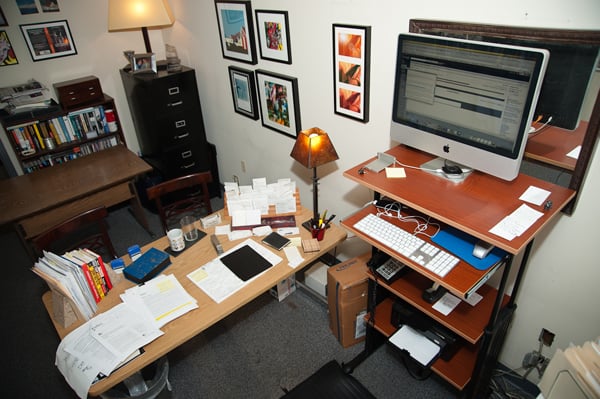Washingtonian senior writer Shane Harris purchased a four-foot-tall standing desk for his office. Photograph by Erik Uecke
Twelve days ago, the sounds of hammering, drilling, and swearing drew coworkers to my office, where they found me assembling a four-foot-tall wood-and-metal tower that looks like a bookcase with the back missing.
“It’s a standing desk,” I explained, trying to keep the sweat out of my eyes. This delighted the onlookers. They’d heard of this contraption, but most had never seen one up close, much less heard of someone actually buying one. (At $220, mine was on the cheaper end of the price range; some models cost upward of $1,500.) A few approached it in cautious amazement. It didn’t look very sturdy. Would it fall over if they touched it? The more fearless among them walked right up and put their hands on the slide-out keyboard shelf, imagining themselves typing an e-mail while rocking on their heels.
But many were incredulous. My new acquisition is very tall. It’s rather severe, a triumph of function over form. And when you consider that it’s meant to keep you from sitting down, it has a kind of medieval torture device thing going on.
“You’re really going to stand at this?” they asked. “All day? What’s that about?”
I felt compelled to defend myself. I pointed out that sitting apparently kills you, which they agreed was a powerful incentive to get off my butt. I also pointed out that I’d witnessed a sit-to-stand conversion up close: My partner replaced his office desk with a counter-height kitchen table more than a year ago, and it’s made him happier, healthier, and more productive. (He had worked at lecterns since 2007, and before that, he used a “laptop lifter” on his desk when he wanted to stand.)
But my real epiphany came on a recent vacation in France. Over the course of a week, in which my diet consisted primarily of duck fat, pastry cream, and red wine—frequently in the same meal—I actually lost weight. I attributed this to the ten to 12 hours a day I spent on my feet, walking the streets, ambling through churches, galleries, and shops, and just generally avoiding anything sedentary. I only sat down to eat. And I slept better and had more energy throughout the day than when I’m at home.
My job frequently keeps me out of the office, but when I’m in, I spend hours hunched over a desk, reading, writing, tweeting, organizing notes, and drawing storyboards. I saw no reason some of these tasks couldn’t be accomplished on my feet, especially if it might keep me fitter—and alive.
See Also:
And so, I’ve embarked on a quest to become a stand-up guy. I’ve sent out a few tweets marking my progress, which prompted encouragement from some passionate members of this upright brigade. An appellate judge in Wisconsin wrote to tell me he’s been using three standing desks since 1988—he has one at court and two at home, where he does most of his work. I became virtually acquainted with Mitch, a freelancer in New York, who is chronicling his own conversion. (Follow him @workstandingup.)
Reading the testimonials of vertical cohort, I find that everyone has the same lists of pluses and minuses. Standing during the day gives you more energy, strengthens the core muscles in your abdomen and back, and produces a heightened sense of alertness. But standing in one place also strains your legs; puts pressure on your lower back, ankles, and feet; and can make you tired, which is exactly what you’re working to avoid. I’m hoping that the minor aches and pains are just part of the rookie experience, and that, like the judge—who is about 35 years my senior—I’ll soon be standing most of the day.
So for those who might like to follow in my footprints, which are becoming an indelible part of my office floor, here are some tips to keep in mind.
1. Keep your old desk handy
I kept my computer desk for a week before deciding to commit to the standup model. It was always there in case I decided I’m just meant to be a sitter.
2. Sit down
We weren’t meant to sit all day, but we weren’t meant to stand in one place, either. I originally had two desks placed at 90-degree angles, and I kept one of them for tasks I prefer to do while sitting, such as reading long stories. I sit down for about 15 to 30 minutes every two to three hours. Even if you don’t have room for two desks, keep your chair. You’ll want it.
3. Buy for height
I’m six-foot-two, and the desk I purchased rises to a maximum height of 49 inches. That’s a lot higher than most models I researched, and this feature was essential. You want your computer to sit at eye level, and you should position your keyboard so that when you type, your arms are parallel to the floor. If you’re tilting your head to see the screen and raising your shoulders to type, or you’re bending over, then you’re going to hurt yourself.
4. Don’t stand on one leg
Resist the temptation to shift your weight to one side, or to prop up a leg on a chair or stool. This just strains your standing leg and puts inordinate pressure on your lower back.
5. Get a mat
You’d be surprised how little support your carpet offers. You’ll find a variety of options if you do a search for “anti-fatigue mat.”
In the week and a half I’ve been standing, it has literally changed the way I work. (For instance, I’d never written a story standing up.) Whether it has changed my life for the better . . . we’ll see. I gave that computer desk to another writer, so there’s no turning back. My editor, who insists routinely I fall in and out of love with new routines, is skeptical. “Talk to me in six months,” she says. “See how you feel about it then.”
But so far, all those positive benefits I accrued in France are still with me in Washington. I’m more alert. I have more energy. And I’m sleeping better. I shall celebrate with a wine-soaked foie gras éclair.


















